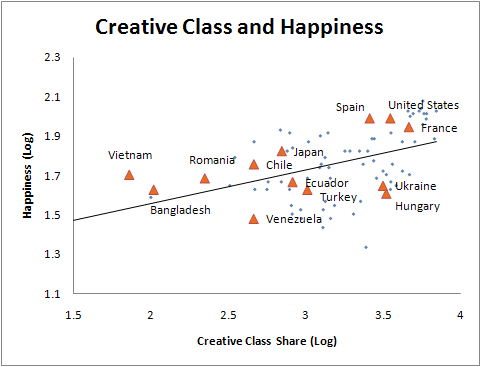by Richard Florida
Over the past week, I've discussed the role of class in economic performance, innovation, and entrepreneurship. But what about happiness?
There is considerable debate over the happiness of nations. The Easterlin paradox suggests that there is little or no relationship between a country's economic development and its level of happiness in comparison to others. An influential paper by economists Justin Wolfers and Betsey Stevenson contradicts the Easterlin paradox, finding a clear relationship between economic development (measured as GDP per capita) and happiness. In other words, countries that increase their wealth become happier, and countries that increase their wealth more than other nations become happier than others.
But what about the effects of class on happiness? Are societies in which a greater share of workers are members of the creative class on balance happier than those with large working class populations?
To get at this, Charlotta Mellander used data on happiness - measured as overall life satisfaction - from the Gallup Organization's World Poll.
The results could not be more striking. Happy nations appear to be creative class nations.
Nations with a large concentration of the working class are far less happy. In fact they appear downright unhappy. Perhaps Marx was right after all about the alienation that comes from industrial work - or, in this case, the unhappiness found in working class locations.
Source of all graphics: Martin Prosperity Institute
We'll be doing more on the connection between class structure and the happiness of nations in the future, so stay tuned.

